Layout and features
Socket-939 now caters for CPUs that range from the £110 Athlon 64 3000+ (1.8GHz) through to the current range-topping FX-55, priced at around £575. Given such a breadth in speed and price, choosing the best motherboard is absolutely paramount.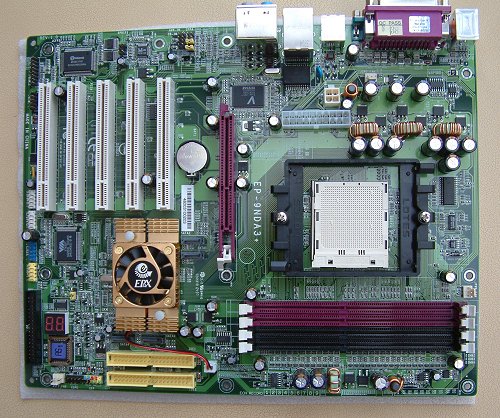
The use of the single-chip nForce3 chipset always allows for a clean-looking motherboard. In fact, EPoX could probably have gotten away with a slimmer PCB. The main 20-pin and auxillary 4-pin power connectors are located above the socket, so you'll need to wind thick cables around the heatsink. This slight problem is accentuated if, like me, you're using a 24-pin EPS PSU that needs an convertor when used with 20-pin boards. I'd like to see both power plugs below the DDR slots.
No discrete north bridge means plenty of room around the socket, though. S754/939 use an easy-as-pie cooler-mounting system which has been made that much simpler with the latest iteration of AMD reference coolers. One can literally change CPUs and coolers within a minute. Top marks to AMD for making it so straightforward.
Further S939 goodness comes from running the CPU in tandem with dual-channel memory. EPoX clearly shows which 2 slots, coloured black and purple, are needed for DC operation. You could, of course, run with a single DRAM module for a 64-bit interface, but that defeats the whole purpose of S939. Given a choice, I'd like to see NVIDIA/EPoX use alternate DIMM slots in dual-channel mode, much like Intel's i875P/i925X chipsets. Most premium memory ships with integrated heatspreaders that tend to be in contact with one another when seated side by side. Add in, say, 3v and ventilation becomes a serious issue. The old problem of a video card blocking off DIMM slots is also present here. I'd really like to see easy RAM insertion and removal without having to remove the video card.
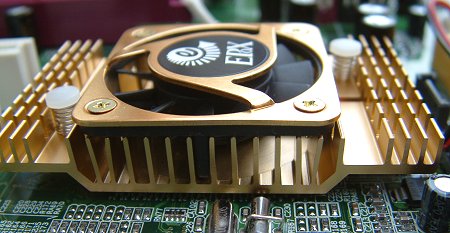
EPoX uses active cooling and an oversized heatsink on the single-chip NVIDIA nForce3 Ultra. We've seen passively-cooled 'Ultras hit 250MHz without too much difficulty, so EPoX is clearly aiming the 9NDA3+ towards the enthusiast. We'll test just how high the board goes a little later on. The fan is also surprisingly quiet; you'd find it hard to notice it in the kind of power system the board's designed for.
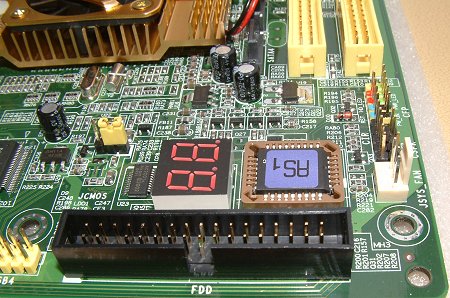
A look further down shows a couple of PATA ports that can be RAIDed in isolation or with the 9NDA3+'s two SATA ports. EPoX has chosen not to implement a further two nForce3-driven SATA ports via an external physical layer. However, RAID0, RAID1, and RAID0+1 formats are still supported. I do like EPoX's use of a debug LED display that stops on a certain code if there's a problem during the POST sequence. The code can then be cross-referenced against the manual for troubleshooting purposes. I also like the colour-coded motherboard-to-case pins, shown on the right-hand side. It makes initial hooking-up that much easier. There's also plenty of room around the clear CMOS jumper. Manufacturers have been guilty of placing it between ICs, making clearing CMOS a tedious job in itself.
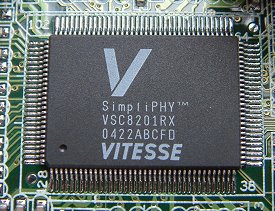
Just above the AGP socket, which has an ample gap between it and the first of five PCI slots, is VITESSE's physical layer that's tasked with providing a conduit for the nForce3's on-chip Gigabit Ethernet support.
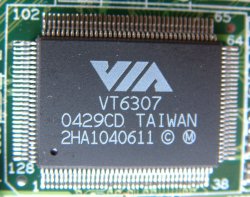
VIA, of all companies, is charged with providing a single-chip FireWire controller on an NVIDIA board. Irony is a beautiful thing. VT6307 is a 2-port ASIC whos low cost has made it a favourite with most major motherboard producers. Incidentally, both ports are run offa flylead.
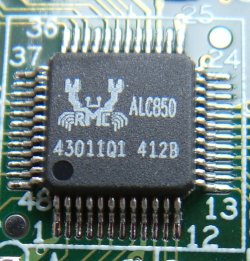
EPoX has tried to make the best job it can with AC'97 sound emanating from the nForce3 Ultra chipset. It's coupled it up with Realtek's 8-channel CODEC that does a decent enough job of 7.1 sound. Of course, users wishing for audio excellence should be pointed in the direction of discrete, dedicated cards.

The I/O section is home to 4 out of 8 USB 2.0 ports. I'd have hoped that EPoX would have integrated at least one FireWire port here. Instead, they're run off a board header via a supplied cable. It's a mixture of old and new here, with legacy ports dominating the left-hand side. Optical and coaxial S/PDIF-out jacks connect up to Realtek's ALC850 CODEC. A decent, clean design that's generally easy to build into.









